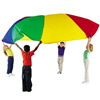Track 2 Music: My Way
Workout Partners: Partners stand back to back, on teacher’s signal, they face each other and greet each other enthusiastically.
Skipping Music: Find a partner – Skipping
- Do the Skip until music stops.
- Look around make sure everyone has a partner. If they don’t enthusiastically invite them to join your group.
Track 3 Music: Alive – Skipping – Crazy Dance Partner: Stand back to back with a new partner. Greet your new partner. This is your crazy dance partner. Do a crazy dance together. Crazy Dance
Track 4 Music: No Roots
Movement: Galloping – Logging Handshake Creating a thumb-on-thumb stack. You can do this one with many people.
Track 5 Music: Hot Steppin Zydeco
Movement: Slide step Grapevine – Happy Salmon This may appear to begin like a “normal” handshake but ends up hands to forearms with the hands flapping like tail fins on forearms
Track 6 Music: Further On
Movement: Like you’re playing your favorite sport – The Whipi Dip (Tea handshake) This one looks like two passing people, holding ice cream cones, will high five when passing. However, hands will pass by each other and continue down to shake the ankles.
Track 7 Music: Horse Race
Movement: Driving a truck. Handshake: One person is the cow and turns interlocks their fingers together with their thumbs pointing down. The other person is the dairy farmer who pulls the thumbs in a milking fashion. Then switch so everyone gets a turn at being a cow and a dairy farmer.
• Workout Buddy Formula: Eventually students will get three buddies during the first class period. Then, once a month, add new buddies. Later during the year, the teacher simply says “Crazy Dance Partner”.
Meet Me in the Middle:
• Hammer fists: Top hands touch bottom, then switch
• Jumping high 5 left, then high 5 right
• Jump and turn 360
• 3 jumping jacks in sync
• Elbow turn right, then left
• Create Your Own
Partner Tag – 3-6 Recess Activities
• Do 3 jumping jacks, then your partner moves away
• Use the 2 finger peace tag.
Offense/Defense & Walking Tag
• Pickle Tag
• Knee Tag
Movement: Skip around the gym.

